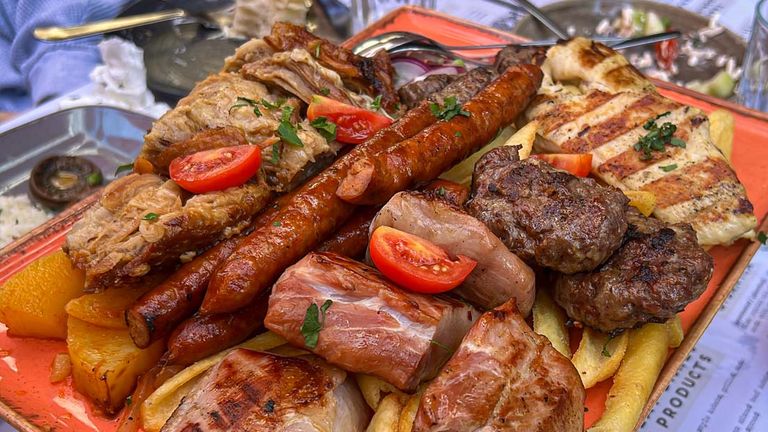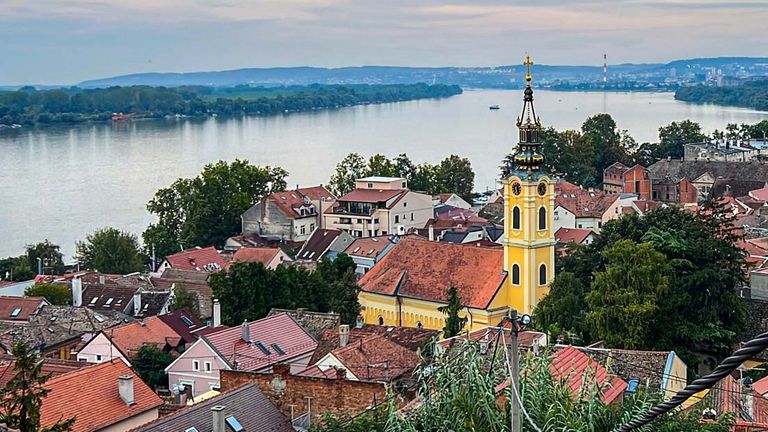When I set foot in Belgrade, Serbia’s Temple of Saint Sava for the first time, I got a peculiar feeling, like I had been there before. The doorway into the world’s largest Serbian Orthodox Cathedral revealed a cavernous nave, uncluttered with chairs or pews, reaching up high to a tremendous domed ceiling. Hanging from it was a monumental multi-wheeled chandelier, illuminating the surrounding walls and mosaics that were adorned with religious iconography.
As I walked under this chandelier, with my head tilted upward to gaze upon its splendor, I realized the moment reminded me of my first impressions of a structure someplace else: Hagia Sophia in Istanbul.
When my guide, Bojana, explained that this magnificent Serbian cathedral was actually designed and constructed with Hagia Sophia in mind, it made perfect sense — in fact, some have nicknamed it “the new Hagia Sophia.”
 Saint Sava was inspired by the Hagia Sophia.
Saint Sava was inspired by the Hagia Sophia.
Credit: 2025 Erik Trinidad
However, comparisons of the two similar structures end with grand chandeliers; while the fourth-century Hagia Sophia has served its purpose as a mosque, then a church and eventually back to a mosque again, Saint Sava has a much shorter history. Completed and opened to the public in 2004 after many setbacks — the founding stone was set in 1935 — the church is now one of the most important shrines in the Serbian Orthodox Church. It’s erected on the grounds of what is believed to be the final resting place of the church’s founder, Saint Sava the Enlightener.
Learning about the history of this awe-inspiring temple was just one highlight of many as I experienced the sights and the scenes of Belgrade, Serbia’s capital city.
More Than a Port of Call
Belgrade is often one of several ports for river cruises traveling down the Danube, but it’s one that definitely warrants more time than that of a single day tour. An important hub of Serbian and Balkan history, it’s a city that dates back more than 7,000 years, from prehistoric times to the Electrical Age of inventor Nikola Tesla and beyond.
Many visitors start in Stari Grad, or Old Town, home of one of the city’s main historical attractions: the Beogradska Tvrdjava (Belgrade Fortress). The multilayered citadel, founded in the third century B.C., still offers great vistas of the confluence of the Danube and Sava rivers, in addition to monuments, churches and other exhibitions found in and around the fortress grounds. The complex lies in the city park known as the Kalemegdan, a pleasant place where I continued strolling on a nice day amidst locals lunching on benches and chess players quietly dueling their intellects at park tables.
 A traditional dish of grilled cevapi, served alongside other meats
A traditional dish of grilled cevapi, served alongside other meats
Credit: 2025 Erik TrinidadBetween the park and Republic Square is the main pedestrian drag of Knez Mihailova — named after 19th-century prince Mihailo Obrenovic — where old buildings have been repurposed for modern shops, cafes, restaurants and art galleries. Within walking distance is the trendy Dorcol neighborhood, with bars and boutiques scattered around its residential streets.
One notable street is the promenade Skadarlija, where live music is performed tableside each night in traditional Serbian restaurants, where diners are served platters of beloved dishes such as grilled cevapi (spiced minced meat) and pohovane paprike (breaded roasted peppers) stuffed with cheese.
I also found vibrant dinner scenes of live music, food and toasts of rakia — local fruit brandy — at the Gastrosor, another promenade of eateries in a revived port district along the Danube.
Outside Old Town
Southeast of Stari Grad is the Vracar neighborhood — home to the Temple of Saint Sava — where you’ll also find the Kalenic Green Market, which tantalizes foodies, and the Nikola Tesla Museum for science and history buffs. The museum not only has interactive exhibitions about electricity; it is also the final resting place of Tesla’s cremated remains, on display in an urn.
Another hybrid resting place/museum is the Museum of Yugoslavia, home to the tomb of Josip Broz Tito, former leader of Communist Yugoslavia (of which Serbia was once part). Here, there are old photos, artifacts and memorabilia of the former Balkan republic, many of which are Tito’s personal effects and gifts given to him by other dignitaries.
 At the top of Gardos Hill, visitors are treated to this view of the Danube River.
At the top of Gardos Hill, visitors are treated to this view of the Danube River.
Credit: 2025 Erik TrinidadCrossing the river into New Belgrade, travelers will discover modern shopping centers and international hotel chains found in other European cities. However, old-world charm can still be found in the bohemian Zemun neighborhood. There, I walked to the top of Gardos Hill — where Millennium Tower rises from a cemetery and the remnants of the 14th-century Gardos Fortress — and was rewarded with a postcard vista of the Danube River. From there, on a pleasant stroll down the hill to the riverfront, I browsed quaint shops and art galleries before ultimately dining riverside with a view of swimming swans.
It’s not the Danube but the Sava River that separates Old and New Belgrade — west and east, respectively — and in the middle lies an island frequented by visitors and locals alike: Ada Ciganlija. The island, along with a river dam, forms the artificial Lake Sava, which has become the city’s beloved place for lakeshore beach activities, whether that's sunbathing, drinking at beach cafes or simply taking out a kayak or stand-up paddleboard from one of the local rental shops. It’s a great place to spend an afternoon or a night out when it’s warm — or, if you’re like me, when you just need a break from all the historical sites and museums.
Beyond Belgrade
Belgrade is essentially the geographic center of Serbia, making it the perfect base to explore the rest of the country by way of day trips.
 Golubac Fortress
Golubac Fortress
Credit: 2025 ltummy/stock.adobe.comRent a car and you can navigate both space and time, so to speak, to different sites representing the region’s long history: Lepenski Vir, site of Europe’s first sedentary settlement of Neolithic man; Viminacium, Roman city-turned-archaeological park of ruins; Golubac Fortress, restored to its 14th-century medieval glory; the 16th-century monasteries within Fruska Gora National Park; and the charming town of Sremski Karlovci, hub of today’s Serbian wineries. While Belgrade may be a brief port-of-call stop on a Danube River cruise, travel advisors can use it as the gateway to the rest of what Serbia has to offer for clients.